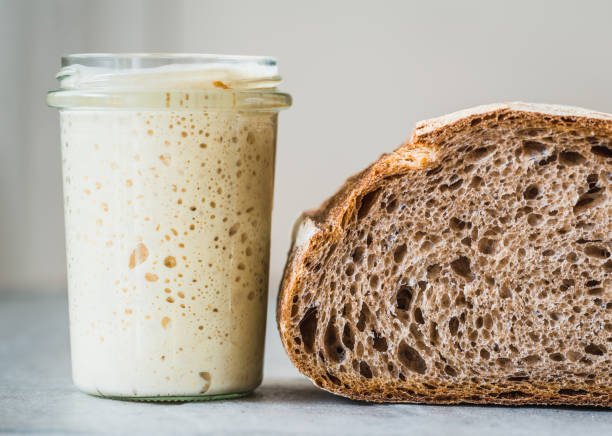History
Sourdough bread is one of the oldest forms of leavened bread, with origins tracing back to ancient Egypt around 1500 BCE. The fermentation process was likely discovered accidentally when dough left out absorbed wild yeast and bacteria from the environment, causing it to rise. This method spread through various cultures, becoming a staple in many diets. In the United States, sourdough gained prominence during the California Gold Rush in the mid-19th century, as miners and settlers relied on it for sustenance. The term "sourdough" became synonymous with these pioneers, and the bread remains a cultural icon in San Francisco.
Fermentation Process
The production of sourdough involves creating a starter—a mixture of flour and water that captures wild yeast and lactobacilli from the environment. Over time, this mixture ferments, developing a stable culture. The fermentation process produces lactic acid, which imparts the characteristic sour flavor, and acetic acid, contributing to the bread's aroma. The acids also strengthen the gluten network, resulting in a chewy texture. The fermentation process can take several days, depending on environmental factors and desired flavor profiles.
Nutritional Profile
Sourdough bread offers several nutritional benefits compared to breads made with commercial yeast. The fermentation process breaks down phytic acid, an antinutrient found in grains, enhancing mineral absorption. Additionally, the presence of lactic acid bacteria may improve gut health by acting as probiotics. Some studies suggest that sourdough bread has a lower glycemic index, leading to a more gradual rise in blood sugar levels. However, the exact nutritional content can vary based on the specific ingredients and fermentation duration.
Cultural Significance
Sourdough holds cultural importance in various regions. In San Francisco, it is a culinary symbol, with local bakeries like Boudin Bakery continuing traditional methods. In France, pain de campagne, a type of sourdough, is a staple in many households. The bread's unique flavor and artisanal production methods have contributed to its enduring popularity worldwide.
Modern Variations
Contemporary bakers experiment with sourdough by incorporating different flours, such as whole wheat, rye, or spelt, to create diverse flavor profiles. Some add ingredients like nuts, seeds, or dried fruits to enhance texture and taste. The rise of home baking has led to a resurgence in sourdough popularity, with enthusiasts sharing techniques and recipes online. Despite these innovations, the fundamental process of natural fermentation remains central to sourdough bread making.
Related Topics
- –Fermentation
- –Lactic Acid Bacteria
- –Breadmaking Techniques
- –San Francisco Cuisine
- –Artisan Baking
- –Probiotics
Sources
- –
Sourdough Bread: A Beginner's Guide - Provides an overview of sourdough bread making.
- –
The Science of Sourdough - Explores the microbiology behind sourdough fermentation.
- –
Sourdough Bread and Health - Discusses the health benefits associated with sourdough consumption.
- –
History of Sourdough Bread - Examines the historical significance of sourdough bread.
- –
Sourdough: A Traditional Bread - Offers a concise overview of sourdough bread.
Key Facts
- –Origin: Ancient Egypt, circa 1500 BCE
- –Main Ingredients: Flour, water, wild yeast, lactobacilli
- –Fermentation Time: Several days, depending on conditions
- –Distinctive Features: Tangy flavor, chewy texture
- –Cultural Significance: Iconic in San Francisco; traditional in French cuisine
